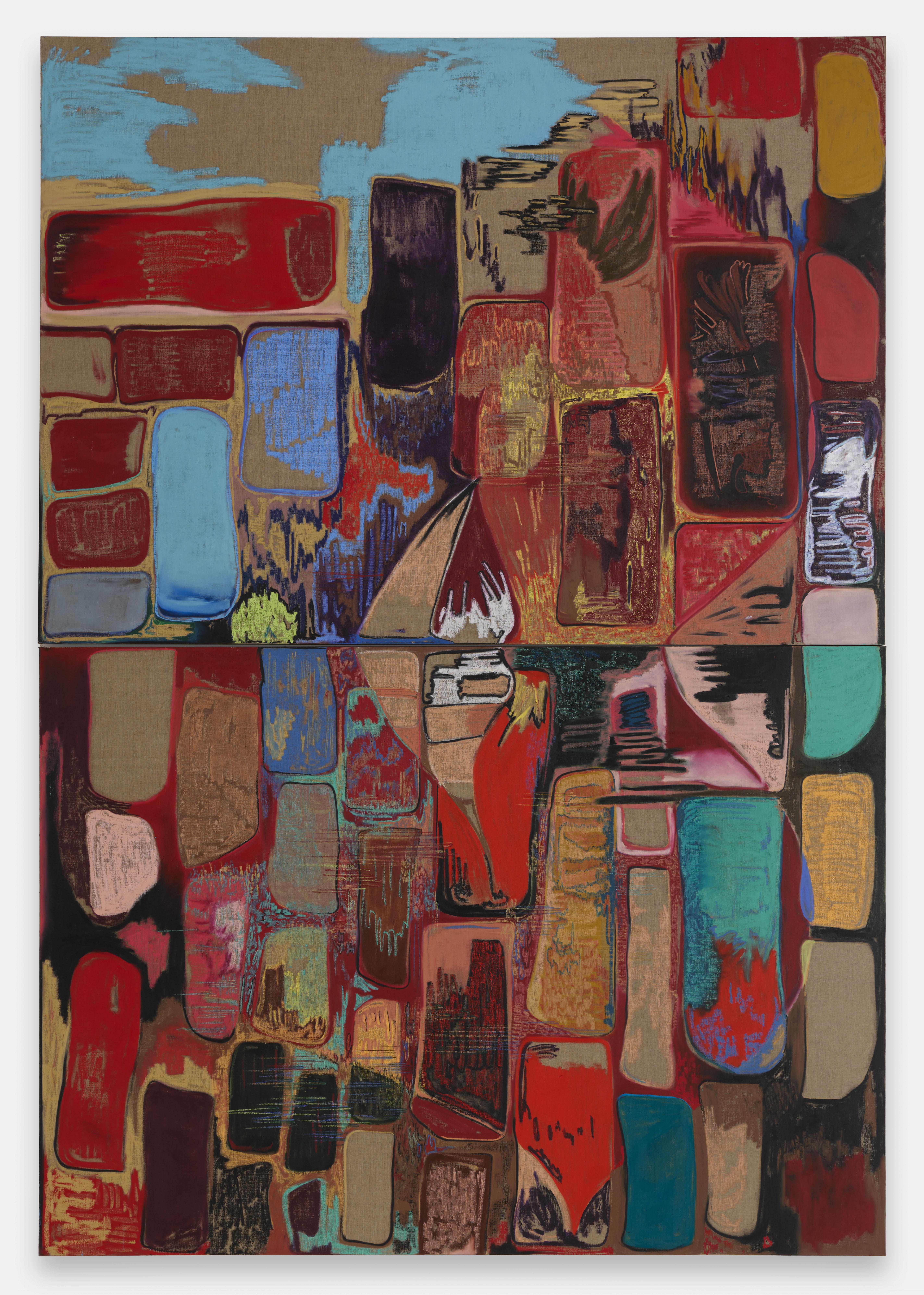A preserved shark, two fried eggs and an unmade bed changed the course of art. A little more than 30 years ago, a new generation of Young British Artists (YBAs) came onto the scene and caught the world’s eye. Soon, Cool Britannia ruled not so much the waves as global culture, with its music, theatre, films — and the works of Damien Hirst, Sarah Lucas, Tracey Emin and many others. The YBAs have long since come of age, the Arts are increasingly sacrificed to budget cuts and an obsession with technology and the mood in the country feels a little gloomier than it did back then. ‘It is a difficult time to be working in the UK, with a struggling economy and high living costs; artists are also faced with lower fees and fewer opportunities,’ acknowledges Priyesh Mistry, National Gallery Associate Curator, Contemporary and Modern projects.
And yet. Creativity remains unbridled. ‘My perspective is that the contemporary-art scene is probably more dynamic than it has ever been,’ says Jennifer Powell, director of The Barber Institute of Fine Arts at the University of Birmingham. ‘I think that might be because there has been so much threat to creative endeavour that, actually, artists are finding ways to carry on.’ After all, as Will Gompertz, director of the Sir John Soane’s Museum in London, says, ‘young artists are people of passion and conviction: they are determined that they have something to say, which they want heard’.
It’s this very dedication that sparks admiration in Oli McCall, senior curator at Compton Verney in Warwickshire: ‘One of the things that always strikes me is the continual inventiveness and passion that drives artists forward. We’re still seeing so many really trying to grapple with the huge issues we’re facing at the moment, whether that’s the climate crisis or the political situation or issues around identity.’ McCall is especially thrilled by a resurgence in narrative painting, with the new generations ‘getting back to using materials in a way that’s really interesting and picking up on themes to do with history, mythology, other ways of existing’ — so much so that he is curating, together with historian Marina Warner, an exhibition on this theme, ‘The Shelter of Stories’, at Compton Verney. ‘I guess, when you’re in a time of flux, you do, inevitably, look back a little to try and find an anchor point, or something you can latch onto.’
Artistic patronage is perhaps not as strong as in the past — ‘there isn’t necessarily a Charles Saatchi around every corner,’ says Gompertz — but more people than ever before are supporting contemporary art: ‘I think the network is not so deep, but it is broader.’ This breadth of patronage has also struck Simon Martin, director of Pallant House in Chichester, West Sussex: ‘There’s a greater democracy — platforms such as Instagram mean that many more people can engage with the work of emerging artists. With the support of the Contemporary Art Society, Art Fund and others, regional museums are now often the first to acquire works, as they can be more nimble than some of the national institutions.’
Places such as the Barber Institute or the Dulwich Picture Gallery are also finding new ways to work with artists, whether by staging solo exhibitions, encouraging them to respond to collections or, as Powell notes, acting as a gateway to communities with which they can work. Beyond the institutional support, Dulwich Picture Gallery Director Jennifer Scott is delighted that ‘established artists are creating a platform for the latest generation of talent, as in Dame Tracey’s artist residency programme in Margate, Kent, and Yinka Shonibare’s Foundation in Lagos, Nigeria’.
That Dame Tracey’s initiative takes place outside London is important and not coincidental. Regionality, believe Mistry and Clarrie Wallis, Director at Turner Contemporary in Margate, is another reason the contemporary art scene remains so lively. ‘Margate is a prime example — a creative haven with three art schools, including Dame Tracey’s TKE Studios, which are funded through alternative models and embody artistic radicality,’ explains Wallis, highlighting how this ‘unique concentration of talent’ is creating a remarkably vibrant environment in the town, which is home to artists Sophie von Hellermann, Lindsey Mendick and Vanessa Raw, as well as Dame Tracey. Elsewhere, adds Mistry, ‘spaces such as g39 in Cardiff and Eastside Projects in Birmingham continue to foster creative and fascinating discussions around artists’ studios and project spaces.’
If only the Government took the leap and increased funding for public institutions, maintains Clare Lilley, Director at the Yorkshire Sculpture Park, ‘it would be a revelation, would affect generations and radically amplify our position in the world’. Until then, she has noticed a growth in less-established artists and emerging galleries inventing new ways of doing things, which is parallel to and counters the art market’s natural tendency to move into ‘safe territory’ during a contraction. Yes, concludes Powell, ‘it’s challenging for young artists at the moment, but I do think that the broad scene is an exciting one’. Here are eight British or UK-based artists aged 40 or under that she and other museum directors and curators have on their radar.
‘The Shelter of Stories’ at Compton Verney, Warwickshire, runs from October 25–February 22, 2026
Will Gompertz of the Sir John Soane’s Museum and Dr Xavier Bray of the Wallace Collection, W1, choose:
Flora Yukhnovich
‘Bold and courageous’ is how Gompertz describes Flora Yukhnovich (b. 1990), referencing last year’s exhibition at the Wallace Collection, Flora Yukhnovich and François Boucher: The Language of the Rococo, in which she took on the 18th-century French painter with great success. Gompertz much admires the ‘collapsing of time’ in Yukhnovich’s work, the way in which she draws inspiration from Boucher.

Frivolity and fairy tales, theatrical style and historical meaning are all woven into Flora Yukhnovich’s 8½ft-tall Folies Bergère, 2024, which references Rococo artist François Boucher.
(Image credit: Flora Yukhnovich/Victoria Miro)
She brings back to life the French painter’s technique so wonderfully that, recalls the Wallace’s Director, Bray, ‘when we did a little catalogue that went with [her exhibition], one of the ideas was to get an art historian to write almost an introduction to Boucher, a fictive introduction, as if he was still alive to Flora’. Her large-scale, semi-abstract paintings, such as the dreamy, theatrical Folies Bergère, which she showed at the Wallace last year, capture the essence of Rococo. ‘All my work revolves around the question of what is serious and what’s frivolous and what creates the distinction between the two and I think the Rococo feels like a period of history that explores that exact question,’ she told Bray last year. It’s precisely ‘this balance between the serious and the frivolous, the real life and the fairy tale, the contemporary and the historic source’ that Gompertz finds ‘quite exceptional’.
Priyesh Mistry of the National Gallery, London, chooses:
Hylozoic/Desires
Himali Singh Soin (b. 1987) and David Soin Tappeser (b. 1985), the duo behind the intriguingly named Hylozoic/Desires, ‘weave experimental poetry and music to propose new, wondrous and hopeful performances and installations,’ says Mistry. Their multimedia pieces are remarkably varied, wildly imaginative and always compelling — whether An Omniscience, a ‘bird opera for flute, oboe, bass flute, bass clarinet, two narrators and one conductor’, or In The Spirit of the Fountain, a performance held to the sounds of the drum among the ruins of Pompeii.
Tate Britain is currently showing their The Hedge of Halomancy (to August 25), which reflects on the Inland Customs Line, a 2,485-mile, mostly hedge barrier that the British erected across India in the 19th century to shore up tax revenues by stamping out salt smuggling. Centred on a 23-minute film installation duly encased in a salt-covered frame, it tells the storyof Mayalee, a character inspired by an Indian courtesan who stood up to the Empire, who uses salt for divinations and triggers a chain of events ranging from termites eating into the hedge to the British commissioner having a change of heart. Shown together with the film are Mayalee’s dress (made from the plastic waste of salt pans) and an embroidered tapestry inspired by the Indian board game Mokshapat (liberation), which became Snakes and Ladders in Britain. As Mistry says, ‘using AI to re-create non-existent images, original music, film and early printing techniques [employing] blocks of soap on textile, they have brought to life a fascinating history that has been all but lost in time’.
Clare Lilley of the Yorkshire Sculpture Park, West Bretton, chooses:
Marguerite Humeau
‘This is so hard!’ erupts Lilley. Her field of interest is outdoor or large-scale sculpture, an art form that is more usually the preserve of maturity: ‘Joan Miró and Tracey Emin, to name only two, didn’t really begin making large sculptures until they were in their fifties. For this kind of endeavour, you need resources, collaboration, resilience and more.’

Curiosity abounds: in sculptor Marguerite Humeau’s Echoes, 2017, the re-created ancient-Egyptian voice of Cleopatra bounces off walls smeared with black-mamba venom.
(Image credit: Marguerite Humeau/TATE)
Nonetheless, there is a younger sculptor who has caught her eye: Marguerite Humeau (b. 1986). Originally French, but working in London, she makes ‘curious, exquisite sculptural forms you’ve never seen before, [which] connect with our earth, life systems, and mythologies’. Humeau often starts from mysteries that fascinate her, such as the origin of the Sphinx, which become springboards for her to create unusual installations, conceived as ‘ecosystems’. In Echoes, a work she presented at Tate Britain in 2017–18, she began with the idea of reviving the voice of Cleopatra and combined a synthetic sound with the sculptures of two gods — semi-abstract, but influenced by ancient Egyptian culture — who are attempting to distil an elixir of life in an alienatingly yellow room where the walls are covered with black-mamba venom: ‘Through these beautiful-repugnant-strange objects,’ says Lilley, ‘she speaks of our planet and our time within it.’
Will Gompertz chooses:
Michael Armitage
Gompertz admits he is cheating by a year when naming Michael Armitage (b. 1984), who turns 41 in 2025, but, he adds, by way of asking for forgiveness: ‘I adore his work.’ A Kenyan-British artist with a foot in Indonesia, Armitage draws on East Africa’s imagery — the lush landscape, the architecture, the animals — without shying away from the issues that affect its people: inequality, violence, politics.
One example is a large-scale piece — painted, as is usual for him, on lubugo (fig-tree-bark) cloth instead of canvas — now at MoMA in New York, US: Curfew (Likoni March 27 2020) captures the moment in which thousands of workers attempted to return home to meet a government-imposed curfew, only to get stuck at the ferry crossing in Likoni, a suburb of Mombasa, in Kenya. Their sheer number and the ferries’ limited capacity caused many people to break curfew, albeit unintentionally — and the police began whipping them. Armitage distorted the picture plane and resorted to bold, sometimes clashing colour to convey the sense of violence. For Gompertz, ‘the way he unites composition and his painterly skills with narrative, and, particularly, with a contemporary political narrative, makes him a really important artist in dialogue across continents’.
Dr Jennifer Powell of The Barber Institute of Fine Arts, Birmingham, and Oli McCall of Compton Verney, Warwickshire, choose:
Farwa Moledina
‘A fascinating artist’, says Powell of Farwa Moledina (b. 1993). ‘One to watch,’ notes McCall. Now based in Birmingham, Moledina, who is of Yemeni-Tanzanian origins, was raised in Dubai and her Muslim faith is important to how she makes artworks, according to Powell, who is particularly struck by her portrayal of women such as Mariam, Christianity’s Mary. Moledina had recently become a mother herself when she began working on Women of Paradise, a textile and embroidery installation inspired by Mariam, but also by Muhammad’s wife, Khadijah; his daughter Fatima; and Asiya, the Pharaoh’s wife that raised Musa (Moses).

Transcending many faiths in tapestry: Farwa Moledina uses Islamic iconography to join communities in Women of Paradise, 2022.
(Image credit: Luke Unsworth)
‘She was thinking about these figures within the Muslim faith, but how they actually transcend multiple faiths,’ explains Powell. ‘A lot of her work is pattern or textile design, using iconography from Islamic art, but brought up to date within the 21st century. She also is a really nice example of an artist who does work with communities. I loved her project at Modern Art Oxford.’ Back Toward Oneness, which closed earlier this year, was the fruit of Moledina’s collaboration with The Date Palm Tree, a group of some 250 Muslim parents, carers and children, and centres on the story of Maryam and Isa — Mary and Jesus. ‘It was about the Islamic concept of communities [Ummah] and how that idea can cross over faiths, borders, boundaries, which,’ points out Powell, ‘is something we all need at the moment in a world in turmoil.’
Andrew Nairne of Kettle’s Yard, Cambridge, chooses:
Oscar Murillo
In 2019, Colombian-born Oscar Murillo (b. 1986) made headlines because he and three fellow artists — Tai Shani, Helen Cammock and Lawrence Abu Hamdan — asked to share the Turner prize for which they had all been nominated. The jury agreed and the four became co-winners. He hasn’t stood still since — literally (he works across multiple locations), as much as figuratively.

Inspired by Monet, created by the public: Oscar Murillo’s The Flooded Garden filled the Turbine Hall of Tate Modern with an oval of canvases, which visitors could paint.
(Image credit: Alamy)
‘Internationally lauded for his bold paintings and installations, Murillo is constantly experimenting and pushing boundaries,’ says Nairne, who quotes the artist’s major project at Tate Modern last year as an example of his innovative approach. Called The Flooded Garden in homage to Claude Monet and his water lilies, this was a participatory installation. Giant canvases hung in an oval space within the Turbine Hall — another reference to Monet, who conceived the elliptical rooms in which his Nymphéas are displayed at the Musée de l’Orangerie in Paris — and members of the public were invited to leave their mark on them. Once filled, they became a wave-swept ocean of blue paint (sprinkled with the odd pink and yellow).
Murillo is not new to participatory work: since 2013, he has been giving canvases to schools in more than 20 countries, so that pupils can doodle, write and draw on them. He presented the project, Frequencies, at venues worldwide, from the 56th Venice Biennale in Italy in 2016 to the Yorkshire Sculpture Park in 2019, and has published two books documenting the steps and featuring the resulting artworks.
Oli McCall of Compton Verney and Simon Martin of Pallant House choose:
Jake Grewal
‘Tremendously atmospheric.’ McCall saw Under the Sky, the Studio Voltaire show of works by Jake Grewal (b. 1994) earlier in the spring, and was blown away by the artist’s ‘amazing’ landscapes. He is not the only one to be impressed — Martin is also much taken with Grewal’s pictures (which feature in the collections of the Fitzwilliam Museum, British Museum and Hepworth Wakefield, as well as Pallant House). ‘His work encompasses painting, ambitious charcoal drawings and, recently, printmaking,’ Martin notes. ‘Central [to it] is the relationship between Man and Nature, drawing on the language of Romanticism and Modern British and European landscape painting through a queer-embodied lens.’

Where the human becomes the landscape: Jake Grewal explores time and transformation in The Ceaseless Cycle of Erosion, 2024.
(Image credit: Sarah Rainer)
Grewal’s solo exhibition at Pallant House last year, ‘Some days I feel more alive’, included many charcoals. However, at Studio Voltaire, he presented larger oil paintings, including a gigantic seascape on a curve, the almost 20ft-long The Ceaseless Cycle of Erosion, which explores the notions of transformation and the passage of time. In the work, several men — or perhaps the same one at different stages — both merge with and emerge from massive rocks that partly block the view of the sea. His paintings, says McCall, ‘are populated by these ghostly, quite ethereal figures, usually male nudes, which are sort of autobiographical. The lines are blurred between the figures and the land-scape and I find that really interesting.’
Jennifer Scott of the Dulwich Picture Gallery and Clarrie Wallis of Turner Contemporary, Kent, choose:
Rachel Jones
One’s in London, one’s in Kent, but Scott and Wallis say the same name: ‘Rachel Jones.’ Jones (b. 1991) is only in her early thirties, but has already exhibited at Tate, ICA Miami and the Museum of Fine Art, Houston, US, as well as, in 2024, designing the Brit Awards trophies, as Dame Tracey and Hirst did before her.

Widely exhibited on both sides of the pond, Rachel Jones’s textured, sensory canvases with recurring symbols, such as Gated Canyons, 2024, consider questions of identity.
(Image credit: Eva Herzog)
Her work spans sculpture, drawing, performance art and, above all, painting — monumental canvases bursting with colour. ‘She creates richly textured, sensory landscapes that provoke powerful emotional responses,’ says Wallis. ‘Through recurring motifs such as mouths — symbolic portals to our inner selves — she examines themes of identity and pushes contemporary painting into experimental territory.’ Her solo exhibition, ‘Gated Canyons’, opening next month in Dulwich, explores another motif: bricks, intended to encapsulate the impact of the outside world on the interior one and reflect on the relationship between public and private spheres. ‘I believe Jones is one of the most exciting artists of our time,’ says Scott. ‘Her works strike a chord with people of all ages and have an inspiring energy.’
‘Gated Canyons’ is at the Dulwich Picture Gallery from June 10–October 19







